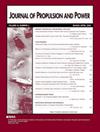Active Energy Management for Enhanced Engine Transient Operations
IF 1.7
4区 工程技术
Q2 ENGINEERING, AEROSPACE
引用次数: 0
Abstract
Combat aircraft often require the engine to accelerate as fast as possible in response to the demand of maneuvering. The engine acceleration rate, however, is limited by the compressor surge constraint, which prevents more fuel addition that, otherwise, could provide for higher net shaft torque, and thus, faster acceleration. This paper examines the idea of using the electric starter/generator (ES/G) system to provide additional net shaft torque during this critical phase of acceleration. The idea is examined by simulations using a quasi-one-dimensional dynamic compressor flow model coupled with a lumped combustor–turbine model. A notional single-spool turbojet with a low overall pressure ratio is modeled and simulated. Simulation results suggest that an ES/G, when used as an electric-assist motor during acceleration, can help the engine to accelerate roughly 11, 48, and 70% faster compared to the case without ES/G participation, by using electric power roughly equivalent to 0.1, 1, and 3% of full-speed fuel combustion power, respectively. Furthermore, the respective increase in the acceleration rate leads to an additional 19, 80, and 113% of propulsion impulse, respectively (i.e., thrust integrated over time), during the first 5 s following the acceleration command.主动能源管理促进发动机瞬态运行
作战飞机通常要求发动机尽可能快地加速以满足机动需求。然而,发动机的加速率受到压气机涌流约束的限制,无法增加燃料,否则就无法提供更高的净轴扭矩,从而无法加速。本文研究了利用电启动器/发电机(ES/G)系统在这一关键加速阶段提供额外净轴扭矩的想法。本文通过使用准一维动态压缩机流动模型和整块燃烧器涡轮模型进行模拟,对这一想法进行了研究。模拟和建模了一架名义上具有低总压比的单涡轮涡喷飞机。仿真结果表明,与没有 ES/G 参与的情况相比,ES/G 在加速过程中作为电动辅助发动机使用时,通过使用分别相当于全速燃料燃烧功率 0.1%、1% 和 3% 的电力,可以帮助发动机加速大约 11%、48% 和 70%。此外,在发出加速指令后的最初 5 秒内,加速度的相应增加分别会带来额外 19% 、80% 和 113% 的推进冲力(即随时间变化的推力)。
本文章由计算机程序翻译,如有差异,请以英文原文为准。
求助全文
约1分钟内获得全文
求助全文
来源期刊

Journal of Propulsion and Power
工程技术-工程:宇航
CiteScore
4.20
自引率
21.10%
发文量
97
审稿时长
6.5 months
期刊介绍:
This Journal is devoted to the advancement of the science and technology of aerospace propulsion and power through the dissemination of original archival papers contributing to advancements in airbreathing, electric, and advanced propulsion; solid and liquid rockets; fuels and propellants; power generation and conversion for aerospace vehicles; and the application of aerospace science and technology to terrestrial energy devices and systems. It is intended to provide readers of the Journal, with primary interests in propulsion and power, access to papers spanning the range from research through development to applications. Papers in these disciplines and the sciences of combustion, fluid mechanics, and solid mechanics as directly related to propulsion and power are solicited.
 求助内容:
求助内容: 应助结果提醒方式:
应助结果提醒方式:


